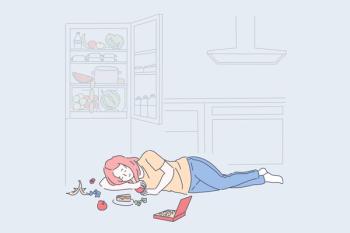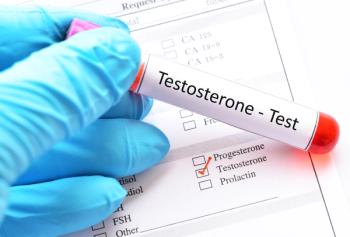
- Psychiatric Times Vol 25 No 6
- Volume 25
- Issue 6
Family Therapy for Adolescents With Anorexia Nervosa: A Brief Review of Family-Based Treatment
Anorexia nervosa is often complicated by devastating medical problems and may result in death. Although studies suggest a multifactorial cause for the disorder, treatment trials have yet to provide clinical guidance about how best to approach anorexia nervosa.
Anorexia nervosa is often complicated by devastating medical problems and may result in death. Although studies suggest a multifactorial cause for the disorder, treatment trials have yet to provide clinical guidance about how best to approach anorexia nervosa. However, recent studies have found that for adolescents who have short-duration anorexia nervosa, a specific form of family-based treatment (FBT) shows promise.
Background
Anorexia nervosa is a severe psychiatric disorder that typically has its onset during adolescence and primarily affects young women. The estimated prevalence of anorexia nervosa is 0.48% to 0.7% in females, and males account for about 10% of the total diagnoses.1 Anorexia nervosa is characterized by overwhelming preoccupation with weight and food, extreme fear of fat or of becoming fat, and refusal to maintain a healthy weight that is often accompanied by a denial of the health consequences of malnutrition, misperception of body shape (ie, body image distortion) by overestimating body size, and loss of menses in postmenarcheal females.
In children and adolescents, the diagnosis of anorexia nervosa is challenging because of limited developmental capacities to report symptoms, as well as difficulties in accurately calculating standardized weight thresholds and determining menstrual status.2 Both the psychological and physical effects of these symptoms lead to severe complications.3 Medical complications include changes in growth hormone, hypothalamic hypogonadism, bone marrow hypoplasia, structural abnormalities of the brain, cardiac dysfunction, and GI difficulties. These result in growth retardation, pubertal delay or disruption, and bone loss.
Psychological symptoms lead to social withdrawal, family conflict, guilt, anxiety, and ultimately, in many cases, academic and work failure. In addition, many patients with anorexia nervosa have other psychiatric disorders, particularly anxiety disorders including obsessive-compulsive disorder and affective disorders. An aggregate mortality rate of approximately 5.6% per decade and a crude mortality rate of 5.1% are reported for patients with anorexia nervosa4: about one-half of the deaths are due to suicide and one-half are secondary to physical complications of anorexia nervosa, particularly cardiac failure.
Prognostic studies of anorexia nervosa are limited, but those that are available predict that about one-half of the patients recover, one-third have considerable improvement, and the remainder follow a chronic course. Adolescent onset and early treatment appear to improve outcomes. Most of those who will recover do so within 5 years of initial presentation. At the same time, some studies indicate that associated psychiatric and social impairments persist even when anorexia nervosa symptoms abate.
The cause of anorexia nervosa is unknown. Studies find evidence of family aggregation of the disorder, and genetic vulnerability likely accounts for a significant proportion of the risk of anorexia nervosa.5 Studies identify neuroanatomical, neurofunctional, neurocognitive, and neurotransmitter differences between patients with anorexia nervosa and controls.6,7 Social and developmental forces are also implicated in the risk of anorexia nervosa. Adolescents may be at particularly high risk because of social forces that focus on importance of appearance and weight during this period, as well as burgeoning autonomy dilemmas faced by teenagers.8
Although progress has been made in understanding the risks of developing anorexia nervosa, treatment for the disorder remains extremely challenging. Studies of adults with anorexia nervosa yield little clinical guidance about how to treat the disorder.9 Studies have been plagued by high levels of discontinuation, making definitive conclusions about treatment effectiveness impossible.
Various treatment strategies have been studied for anorexia nervosa, including cognitive-behavioral therapy (CBT), individual supportive therapies, nutritional therapies, antipsychotics (both typical and atypical), and antidepressants. The main conclusion that can be drawn from these studies is that most treatments are not acceptable to adult patients with anorexia nervosa.10 It also appears that standard nutritional counseling and fluoxetine do not confer systematic benefit for anorexia nervosa despite the common clinical use of these therapies.11,12
Hospitalization may be helpful in short-term weight restoration, but long-term benefits have not been identified. A recent study of adolescents found that those randomized to outpatient treatment did as well as those who were treated in a specialized hospital service for 3 months.13
In contrast to these disappointing findings in adults with anorexia nervosa, both uncontrolled and controlled outpatient treatment studies of adolescents with anorexia nervosa suggest that family therapy is likely to be helpful with this age group.14Family-based treatment
The seminal uncontrolled family treatment study was conducted by Minuchin and colleagues15 in the late 1970s. Using a structural family therapy approach in which family members were helped to change their relationship patterns to promote better communication, resolve conflicts, and support appropriate independence, the investigators found that about 80% of their patients improved and maintained improvement over time. Inspired by these findings and informed by their experience with a long-term inpatient service for adolescent eating disorders, Dare and Eisler,16 at the Maudsley Hospital in London, developed a specific form of FBT that aimed to put parents in charge of weight restoration in their malnourished children.16 They identified several key treatment strategies:
• Increase parental anxiety about the disorder to encourage them to take definitive action to change disordered eating and to promote weight gain.
• Reduce parental guilt for having caused the disorder to increase their sense of competence.
• Empower parents to be in charge of decision making about how best to correct disordered eating and restore weight.
• Educate parents through expert consultation about anorexia nervosa rather than explicit advice giving or meal planning.
• Externalize anorexia nervosa and define it as a disease state to allow parents to take on the challenging behaviors as they would do for any other medical disease.
The usual FBT model is structured into about 20 whole-family 50-minute sessions that take place during the course of a year. The treatment initially targets weight restoration above all other considerations. At every session, the patient's weight progress is illustrated to the parents and their efforts to try to promote normal eating and weight gain praised. Families typically struggle in the initial sessions to change their family routines to ensure that the patient's eating is the central priority. This often means that one or both (if there are 2) parents take leave from work to refeed their child for several weeks, just as they might do for a child with any other serious medical illness.
Parents often must confront their differences in how to approach the problem of getting their child to eat, but they usually find that when they agree on a strategy it is more successful. There is also a family meal held early in treatment during which the therapist observes and coaches the parents in how to be consistent in their requests and insistent in adherence, while also constraining their frustration with what appears to be defiance and disobedience.
If the patient has siblings, they are asked to refrain from helping with weight restoration or meal time regimens, but they are asked to recognize how difficult this is for their sister or brother with anorexia nervosa and to try to find ways to support them during this period. For older siblings this might mean talking to them, playing games with them, or watching a video to distract them. Younger siblings sometimes make cards or drawings or help their sibling with household chores. The idea is to use the whole family as a resource to help confront, change, and ultimately move beyond the problem that anorexia nervosa is causing for all of them.
The second part of treatment begins when the adolescent with anorexia nervosa has gained weight and is eating without conflict under parental supervision. The aim of this part of treatment is to ask the parents to promote age-appropriate activities and eating behaviors for the adolescent. In a typical case, parents hand over control of eating gradually to see how their child manages this challenge. There is usually a learning curve for the adolescent, but the enjoyment of being with friends and the reduced worry and conflict in the family typically help to make this phase go smoothly.
The final part of treatment examines adolescent issues and how the family's role has changed as a result of having struggled with anorexia nervosa. In this part of the treatment, the family focuses on what they have learned in therapy by taking on the difficult problem of anorexia nervosa; examining the effects of this struggle on their family, both good and bad; and anticipating future issues they may face, particularly family changes as a result of increased adolescent autonomy.
Although FBT was described by Dare and Eisler, the approach was mostly confined to London or to those under the direct supervision and training at the Maudsley Hospital until the approach was manualized and published by Lock and colleagues17 and made available in other settings. A parent guidebook was published to provide parents with an additional resource as they struggle to combat the challenging behaviors associated with anorexia nervosa in family treatment.18 Research findings Research supporting FBT for anorexia nervosa has been develop- ing for the past 20 years. The initial study published in 1987 by Russell and colleagues19 was the first to demonstrate systematic benefits of a particular treatment, which was FBT, for adolescents with short-duration anorexia nervosa. In that study, adolescents who had anorexia nervosa for less than 3 years and who were treated with FBT had significantly better outcomes than did a similar group that was treated with individual supportive therapy. This superiority was maintained through a 5-year follow-up.20
Subsequently, to assess the importance of family criticism on outcome, a study comparing whole-family counseling with counseling of parents on their own found no overall differences in outcomes between the 2 forms of FBT.21 However, in families with high levels of criticism of the patient, seeing the parents separately for counseling was superior. These results held up at follow-up.22
A small study compared FBT to a form of individual therapy aimed at promoting individuation and autonomy.23 This study found that FBT was more effective in restoring physical health, but no differences were found on psychological outcomes.
The first and largest study to use the manualized form of FBT found that FBT was highly efficient.24 Families who received only 10 sessions of FBT in 6 months did as well as those who received 20 sessions in a year. However, patients with the most severe degree of obsessional thinking about their weight as well as families with divorce, remarriage, or a single parent did better with longer treatment. Follow-up of the cohort from this study found that treatment gains were maintained 4 years after the end of treatment.25
Although definitions of remission and recovery are contested in anorexia nervosa, using conservative estimates of weight normalization and psychological normalization on standardized measures shows that between 70% and 80% of adolescents treated with FBT had recovered at the end of treatment and follow-up.26 Furthermore, preliminary data suggest that leveraging parental resources may decrease the cost of treatment.27Future directions for FBT
Current research provides evidence of the benefits of FBT for adolescent anorexia nervosa of short duration; however, support for a differential benefit of the approach compared with other forms of therapy is more limited. Studies to address this gap in knowledge have begun. A collaborative study funded by the NIMH at Stanford University and the University of Chicago has completed treatment of 120 patients randomized to either FBT or individual therapy aimed at supporting individuation and adolescent autonomy. Results of that study should be available next year.
Another 7-site collaborative study (Stanford University, Cornell University, Washington University, Sheppard Pratt Hospital, University of Toronto, Laureate Hospital, University of California, San Diego) also funded by the NIMH is just getting under way. The plan is to randomize 240 patients to either FBT or systemic family therapy. The study will also examine the benefits of adding fluoxetine to both forms of family therapy. The results of these 2 studies should provide important clinical information about which treatments are better, as well as guidance for better matching of treatments to specific subpopulations of adolescents with anorexia nervosa.
A trial designed to see whether FBT can reduce the rate of conversion to full-syndrome anorexia nervosa in adolescents with prodromal symptoms of the disorder has begun at Mount Sinai Hospital in New York. In a study at Duke University, researchers are comparing FBT to a group family therapy program. Other studies using FBT are taking place elsewhere. In London and in Dresden, Germany, a study directed by the Maudsley group is examining a multifamily group format of FBT. The potential for FBT to reduce the need for hospitalization is being examined in Sydney, Australia, in collaboration with the University of Sydney.
In addition to these studies for anorexia nervosa, le Grange and colleagues28 at the University of Chicago recently studied a population of adolescents with bulimia nervosa, including a randomized clinical trial that compared FBT with supportive individual treatment. This study found that patients who received FBT had higher abstinence rates from binge eating and purging than those who recieved individual treatment. In contrast, a study from the Maudsley group in London found CBT was more cost-effective than FBT for bulimia nervosa in this age group.29
Despite the encouraging data about FBT for adolescent anorexia nervosa and the evolving research related to it, much remains to be studied. One of the key issues will be to develop and test dissemination strategies for FBT should it prove to be the initial treatment of choice. Current providers are generally unprepared to use FBT. One small dissemination study found that the approach can be replicated, but larger and more focused attention to this issue is needed.30 As noted, it remains unclear how helpful FBT is for bulimia nervosa in adolescents; larger randomized clinical trials with active comparison treatments are required to provide more definitive guidance about this. Clinicians can help support these efforts by joining organizations to advocate for the need for eating disorder research and, when feasible, referring patients to ongoing studies in their communities.
References:
References
1. Hoek HW, van Hoeken D. Review of the prevalence and incidence of eating disorders. Int J Eat Disord. 2003;34:383-396.
2. Bravender T, Bryant-Waugh R, Herzog D, et al; Workgroup for Classification of Eating Disorders in Children and Adolescents. Classification of child and adolescent eating disturbances. Int J Eat Disord. 2007;40:S117-S122.
3. Golden NH, Katzman DK, Kreipe RE, et al; Society for Adolescent Medicine. Eating disorders in adolescents: position paper of the Society for Adolescent Medicine: medical indications for hospitalization in an adolescent with an eating disorder. J Adolesc Health. 2003;33:496-503.
4. Sullivan PF. Mortality in anorexia nervosa. Am J Psychiatry. 1995;152:1073-1074.
5. Bulik CM, Sullivan PF, Tozzi F, et al. Prevalence, heritability, and prospective risk factors for anorexia nervosa. Arch Gen Psychiatry. 2006;63:305-312.
6. Muhlau M, Gaser C, Ilg R, et al. Gray matter decrease in the anterior cingulate cortex in anorexia nervosa. Am J Psychiatry. 2007;164:1850-1857.
7. Kaye WH, Frank GK, Bailer UF, et al. Serotonin alterations in anorexia and bulimia nervosa: new insights from imaging studies. Physiol Behav. 2005;85:73-81.
8. Levine M, Harrison K. Media's role in the perpetuation and prevention of negative body image and disordered eating. In: Thompson J, ed. Handbook of Eating Disorders and Obesity. Hoboken, NJ: John Wiley & Sons; 2004;695-717.
9. Bulik CM, Berkman N, Kimberly A, et al. Anorexia nervosa: a systematic review of randomized clinical trials. Int J Eat Disord. 2007;40:310-320.
10. Halmi KA, Agras WS, Crow S, et al. Predictors of treatment acceptance and completion in anorexia nervosa: implications for future study designs. Arch Gen Psychiatry. 2005;62:776-781.
11. Walsh BT, Kaplan AS, Attia E, et al. Fluoxetine after weight restoration in anorexia nervosa: a randomized clinical trial. JAMA. 2006;295:2605-2612.
12. Pike K, Walsh BT, Vitousek K, et al. Cognitive-behavioral therapy in the posthospitalization treatment of anorexia nervosa. Am J Psychiatry. 2004;160:2046-2049.
13. Gowers SG, Clark A, Roberts C, et al. Clinical effectiveness of treatments for anorexia nervosa in adolescents. Br J Psychiatry. 2007;191:427-435.
14. le Grange D, Lock J. The dearth of psychological treatment studies for anorexia nervosa. Int J Eat Disord. 2005;37:79-81.
15. Minuchin S, Rosman B, Baker I. Psychosomatic Families: Anorexia Nervosa in Context. Cambridge, Mass: Harvard University Press; 1978.
16. Dare C, Eisler I. Family therapy for anorexia nervosa. In: Garner DM, Garfinkel P, eds. Handbook of Treatment for Eating Disorders. New York: Guilford Press; 1997;307-324.
17. Lock J, le Grange D, Agras WS, Dare C. Treatment Manual for Anorexia Nervosa: A Family-Based Approach. New York: Guildford Publications, Inc; 2001.
18. Lock J, le Grange D. Help Your Teenager Beat an Eating Disorder. New York: Guilford Press; 2005.
19. Russell GF, Szmukler GI, Dare C, Eisler I. An evaluation of family therapy in anorexia nervosa and bulimia nervosa. Arch Gen Psychiatry. 1987;44:1047-1056.
20. Eisler I, Dare C, Russell GF, et al. Family and individual therapy in anorexia nervosa: a five-year follow-up. Arch Gen Psychiatry. 1997;54:1025-1030.
21. Eisler I, Dare C, Hodes M, et al. Family therapy for adolescent anorexia nervosa: the results of a controlled comparison of two family interventions. J Child Psychol Psychiatry. 2000;41:727-736.
22. Eisler I, Simic M, Russell G, Dare C. A randomized controlled treatment trial of two forms of family therapy in adolesdent anorexia nervosa: a five-year follow-up. J Child Psychol Psychiatry. 2007;48:552-560.
23. Robin AL, Siegal PT, Moye AW, et al. A controlled comparison of family versus individual therapy for adolescents with anorexia nervosa. J Am Acad Child Adolesc Psychiatry. 1999;38:1482-1489.
24. Lock J, Agras WS, Bryson S, Kraemer HC. A comparison of short- and long-term family therapy for adolescent anorexia nervosa. J Am Acad Child Adolesc Psychiatry. 2005;44:632-639.
25. Lock J, Couturier J, Agras WS. Comparison of long-term outcomes in adolescents with anorexia nervosa treated with family therapy. Am J Child Adolesc Psychiatry. 2006;45:666-672.
26. Couturier J, Lock J. What constitutes remission in adolecent anorexia nervosa: a review of various conceptualizations and a quantitative analysis. Int J Eat Disord. 2006;39:175-183.
27. Lock J, Couturier J, Agras WS. Costs of remission and recovery using family therapy for adolescent anorexia nervosa: a descriptive study. Eating Disorders. In press.
28. le Grange D, Crosby RD, Rathouz PJ, Leventhal BL. A randomized controlled comparison of family-based treatment and supportive psychotherapy for adolescent bulimia nervosa. Arch Gen Psychiatry. 2007;64: 1049-1056.
29. Schmidt U, Lee S, Beecham J, et al. A randomized controlled trial of family therapy and cognitive behavior therapy guided self-care for adolescents with bulimia nervosa and related conditions. Am J Psychiatry. 2007;164:591-598.
30. Loeb K, Walsh B, Lock J, et al. Open trial of family-based treatment for adolescent anorexia nervosa: evidence of successful dissemination. J Am Acad Child Adolesc Psychiatry. 2007;46:792-800.
Articles in this issue
over 17 years ago
Child and Adolescent Psychiatry: The Next 10 Yearsover 17 years ago
The Links Between PTSD and Eating Disordersover 17 years ago
ECT Response Prediction: From Good to Greatover 17 years ago
Diagnosing and Treating ADHD in Adultsover 17 years ago
Evaluation and Management of Low Back Pain: Part 1over 17 years ago
The Body Bears the Burden: Trauma, Dissociation, and Disease, 2nd edover 17 years ago
Neurotheology: Are We Hardwired for God?over 17 years ago
Washington Report -- May 2008Newsletter
Receive trusted psychiatric news, expert analysis, and clinical insights — subscribe today to support your practice and your patients.

















